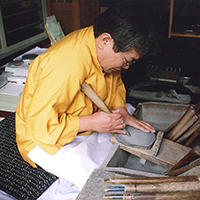Purple inkstone with form like burial mound in shape of dōtaku.
- Inkstone carving
- Presented in 2014
- H 4.0 x W 20.0 x D 25.0 cm
-
$7,815
The prices of the artworks on Gallery Japan are determined by the artists themselves and are published directly on the website.
-
-
*
according to today's currency rate
-
*
shipping fees not included
-
*
I try to design the "spirit" we have in the Japanese culture that we have developed throughout our long history. The shape of this ink stone was inspired by the symmetry design of the bronze bell-shaped vessel doutaku made in the Yayoi period, where we can feel the intelligence and dignity of the Japanese people in the ancient times. I made this piece while imagining the eternity and universality of the Chinese Tankei stone.
| Category | Inkstone carving |
|---|---|
| Year Presented | 2014 |
| Dimensions | H 4.0 x W 20.0 x D 25.0 cm |
| Materials | Tankei stone (China) |
| Exhibition | The 61st Japan Traditional Kōgei Exhibition |
-
Inkstone carving
Inkstones are used in brush calligraphy to grind the ink for writing characters. Inkstones are highly valued writing tools, and the process of ink grinding is regarded as a calming practice preceding calligraphic activities. First, the rough shape of the inkstone is cut out of the base rock. Next, a long-handled chisel is used to cut a flat surface where the ink will be ground and a well where the ink will gather. The final form is coated with a finish of wax or lacquer. Popular varieties of stone include Amehata slate (amehataishi) from Yamanashi prefecture, akamaishi schalstein from Yamaguchi prefecture, and hōmeiseki shale and slate from Aichi prefecture.
Hozan Nagura

As stone materials I use kimpo-seki, engan-seki, and homei-seki, collected around Kadoya, and the suzuri (ink stone) made of these three types of stone are called “Horaiji Suzuri.” Not only do I want to improve and cultivate the techniques handed down by my predecessors, and pass them on to the next generation, but I also want to develop suzuri from a simple calligraphy utensil to a work of art as a “vessel imbued with heart” that expresses the spirit and aesthetic sense of the Japanese people. I do not want to just follow a Chinese style, rather I aim to elevate the value of suzuri toward a new cultural and artistic domain of Japanese style; with this hope, I carry out my day-to-day production.

